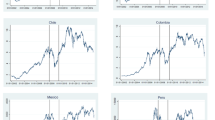Abstract
This paper provides a study of the relationship between money growth variability, velocity, and the stock market, using recent advances in financial econometrics. We estimate a trivariate VARMA, GARCH-in-Mean, BEKK model to quantify the effects of financial market and money supply instability. We investigate the robustness of the results to different definitions of money using monthly Divisia indices for the United States from the Center for Financial Stability (CFS). Empirical evidence supports significance of financial market and money supply volatility, and we conclude that Friedman’s money supply volatility hypothesis is alive and well.








Similar content being viewed by others
References
Barnett WA (1980) Economic monetary aggregates: an application of aggregation and index number theory. J Econ 14:11–48
Barnett WA, Liu J, Mattson RS, van den Noort J (2013) The new CFS Divisia monetary aggregates: design, construction, and data sources. Open Econ Rev 24:101–124
Belongia MT, Ireland PN (2014) The Barnett critique after three decades: A new Keynesian analysis. J Econ 183:5–21
Belongia MT, Ireland PN (2015a) A ‘working’ wolution to the question of nominal GDP targeting. Macroecon Dyn 9:508–534
Belongia MT, Ireland PN (2015b) Interest rates and money in the measurement of monetary policy. Journal of Business and Economic Statistics 33:255–269
Brocato J, Smith KL (1989) Velocity and the variability of monetary growth: Evidence from Granger causality tests. J Money Credit Bank 21:258–261
Dickey DA, Fuller WA (1981) Likelihood ratio statistics for autoregressive time series with a unit root. Econometrica 49:1057–72
Elliot G, Rothenberg TJ, Stock JH (1996) Efficient tests for an autoregressive unit root. Econometrica 64:813–836
Engle RF, Kroner KF (1995) Multivariate simultaneous generalized ARCH. Econometric Theory 11:122–150
Fisher D, Serletis A (1989) Velocity and the growth of money in the United states, 1970–1985. J Macroecon 3:323–332
Friedman M (1983) Monetary variability: The United States and Japan. J Money Credit Bank 15:339–343
Friedman M (1984) Lessons fron the 1979–1982 monetary policy experiment. American Economic ReviewPapers and Proceedings 74:397–400
Friedman M (1988) Money and the stock market. J Polit Econ 96:221–245
Grier KB, Henry ÓT, Olekalns N, Shields K (2004) The asymmetric effects of uncertainty on inflation and output growth. J Appl Econom 19:551–565
Hall TE, Noble NR (1987) Velocity and the variability of money growth: Evidence from Granger causality tests. J Money Credit Bank 19:112–116
Hendrickson JR (2014) Redundancy or mismeasurement? a reappraisal of money. Macroecon Dyn 18:1437–1465
Jarque CM, Bera AK (1980) Efficient tests for normality, homoscedasticity, and serial independence of regression residuals. Econ Lett 6:255–259
Judd JP, Motley B (1984) The great velocity decline of 1982-83: a comparative analysis of m1 and m2. Federal Reserve Bank of San Francisco Economic Review:56–74
Kocherlakota N (2013). https://www.minneapolisfed.org/news-and-events/presidents-speeches/low-real-interest-rates-executive-summary
Kroner KF, Ng VK (1998) Modeling asymmetric comovements of asset returns. Rev Financ Stud 11:817–844
Kwiatkowski D, Phillips PCB, Schmidt P, Shin Y (1992) Testing the null hypothesis of stationarity against the alternative of a unit root. J Econ 54:159–178
Ljung T, Box G (1979) On a measure of lack of fit in time series models. Biometrica 66:66–72
Mehra YP (1989) Velocity and the variability of money growth: Evidence from Granger causality tests. J Money Credit Bank 21:262–266
Phillips PCB, Perron P (1988) Testing for a unit root in time series regression. Biometrica 75:335–346
Santoni GJ (1987) Changes in wealth and the velocity of money. Federal Reserve Bank of St. Louis Review 67:16–26
Serletis A, Gogas P (2014) Divisia monetary aggregates, the great ratios, and classical money demand functions. J Money Credit Bank 46:229–241
Serletis A, Istiak K (2016) Are the responses of the U.S. economy asymmetric to positive and negative money supply shocks? Open Econ Rev 27:303–316
Serletis A, Koustas Z (2016) Monetary neutrality. forthcoming
Serletis A, Rahman S (2009) The output effects of money growth uncertainty: Evidence from a multivariate GARCH-in-mean VAR. Open Econ Rev 20:607–630
Serletis A, Rahman S (2015) On the output effects of monetary variability. Open Econ Rev 26:225–236
Serletis A, Shahmoradi A (2006) Velocity and the variability of money growth: Evidence from a VARMA, GARCH-M model. Macroecon Dyn 10:652–666
Serletis A, Istiak K, Gogas P (2013) Interest rates, leverage, and money. Open Econ Rev 24:51–78
Tatom JA (1983) Was the 1982 velocity decline unusual? Federal Reserve Bank of St. Louis Review 67:5–15
Thornton J (1995) Friedman’s money supply volatility hypothesis: Some international evidence. J Money Credit Bank 27:288–292
Author information
Authors and Affiliations
Corresponding author
Additional information
This paper is based on Chapter 3 of Karl Pinno’s Ph.D. dissertation at the University of Calgary. We would like to thank an anonymous referee, the Editor, and the members of Karl’s dissertation committee: Daniel Gordon, David Walls, Herbert Emery, and Patrick Coe.
Rights and permissions
About this article
Cite this article
Pinno, K., Serletis, A. Money, Velocity, and the Stock Market. Open Econ Rev 27, 671–695 (2016). https://doi.org/10.1007/s11079-016-9400-5
Published:
Issue Date:
DOI: https://doi.org/10.1007/s11079-016-9400-5




